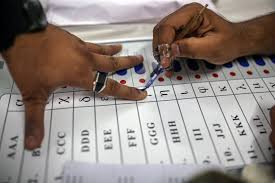Ahead of Bihar polls, Election Commission makes webcasting must for all polling stations

As Bihar prepares for its upcoming assembly elections, the Election Commission of India (ECI) has introduced a major change. It now requires webcasting at every polling station that has internet access. This marks a bold step toward transparent and fair elections.
Previously, the ECI used webcasting at only selected stations, mostly in sensitive areas. Now, Bihar becomes the first state where webcasting will happen across all stations with the necessary infrastructure.
What Is Election Webcasting?
Webcasting means live streaming activities at polling booths on election day. Cameras are installed to capture real-time footage. This footage is sent to monitoring rooms at the constituency, district, and state levels. Officials watch the footage to check if polling rules are followed.
Importantly, the cameras do not point at voting machines or VVPAT slips. This protects the voter’s privacy. The focus remains on checking the smooth conduct of polling—staff activity, polling agents’ presence, and voter movement.
Why the ECI Took This Step
The decision follows feedback and lessons from previous elections. In earlier polls, webcasting covered only about half of the polling booths. Some parties and observers raised concerns about polling-day transparency.
To address this, the ECI decided to increase visibility and accountability. The Bihar elections will serve as the first full trial of this approach. If successful, this model could extend to other states in the future.
How Will It Work?
1. Camera Setup
Booths with internet will get cameras that stream live video to control rooms. Officials at these centers will watch the video for any violations.
2. Real-Time Monitoring
At the state, district, and constituency levels, control rooms will run all day. Officers will check footage at regular intervals. They will look for irregularities like unauthorized people, delays, or staff absence.
3. Backup Plans
In rural or remote areas without internet, polling officers will use video or photo recordings. These will help ensure proper records even when live streaming isn’t possible.
4. Privacy Protection
Cameras will not capture how voters cast their ballots. The EC has set clear instructions to keep voting confidential and secure.
Other Key Reforms in Bihar
The EC is also rolling out several reforms beyond webcasting:
- Fewer voters per booth: Each polling station will serve up to 1,200 voters, down from the earlier 1,500. This change should reduce crowding and speed up the process.
- More urban booths: Densely populated cities will get additional polling stations.
- Mobile phone deposit zones: Voters must leave their phones outside booths to avoid misuse.
- Unified app system (ECINET): The Commission will launch a digital platform to connect different election apps for better coordination.
These reforms aim to make voting more efficient and less prone to confusion or manipulation.
Benefits of 100% Webcasting
The EC expects several benefits from full-scale webcasting:
- Improved Transparency: Voters and officials will know the process is being monitored.
- Fewer Violations: Cameras will deter people from engaging in wrongful acts.
- Faster Action: Officials can spot problems in real-time and send help quickly.
- Post-poll Evidence: Recordings can help during investigations or complaints.
Together, these advantages can build greater public trust in the election process.
Challenges Ahead
Despite the benefits, some hurdles remain:
- Internet Access: Not all polling areas have strong or reliable connections.
- Technical Issues: Equipment might fail or break down, especially in remote zones.
- Staff Training: Officials must learn to use cameras and manage tech smoothly.
- Power Supply: Some regions may face power cuts, affecting video streaming.
The EC has prepared alternative plans and training programs to deal with these issues.
A New Era of Voting in India?
The full webcasting plan may set a national example. If Bihar sees clean and well-run elections, other states could follow. Voters may feel more confident knowing that polling day is under close watch.
By combining cameras, digital tools, and well-trained staff, the EC is trying to modernize how elections work in India.
Conclusion
The Election Commission’s decision to implement 100% webcasting in Bihar reflects a major push toward accountable, secure, and fair elections. While challenges exist, the Commission appears ready with backup plans and digital innovations.
With these changes, voters in Bihar can expect a safer and more transparent election experience. If this experiment succeeds, it could soon become the norm for all future elections across India.






